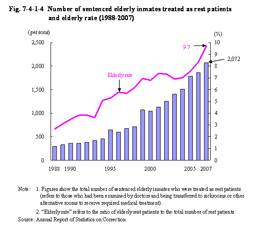| Previous Next Index Image Index Year Selection | |
|
|
4 Status of medical care, etc. for elderly inmates Among sentenced inmates under 65 years of age (hereinafter referred to as “non-elderly sentenced inmates” in this sub-section), respiratory system diseases was the most common with 6,714 persons (34.9%), followed by musculoskeletal and connective tissue diseases with 3,165 persons (16.5%), and digestive system diseases with 2,765 persons (14.4%), in that order. Among sentenced inmates aged 65 or older (hereinafter referred to as “elderly sentenced inmates” in this sub-section), respiratory system diseases was the most common with 493 persons (23.8%), followed by digestive system diseases with 303 persons (14.6%) and cardiovascular diseases with 298 persons (14.4%), in that order. Compared to non-elderly sentenced inmates, elderly inmates had noticeably more cardiovascular diseases and neoplasms (tumors). Table 7-4-1-3 Number of sentenced inmates by type of disease and age group (2007) Fig. 7-4-1-4 shows the number and elderly rate of sentenced inmates who were treated as rest patients (refers to those who had been examined by doctors and detained in sickrooms or other alternative rooms to receive the necessary medical treatment) over the last 20 years.Fig. 7-4-1-4 Number of sentenced elderly inmates treated as rest patients and elderly rate (1988–2007) The number of elderly sentenced inmates who were treated as rest patients has been on an increasing trend, increasing from 299 persons in 1988 to 2,072 persons in 2007. The elderly rate of sentenced inmates who were treated as rest patients has been also on an increasing trend, increasing from 2.7% in 1988 to 9.7% in 2007. |

